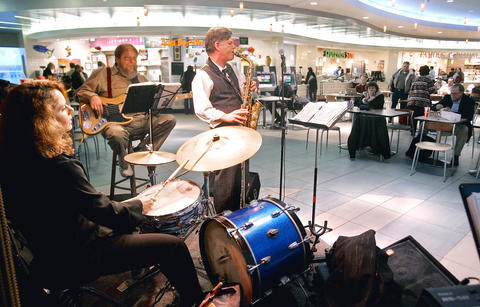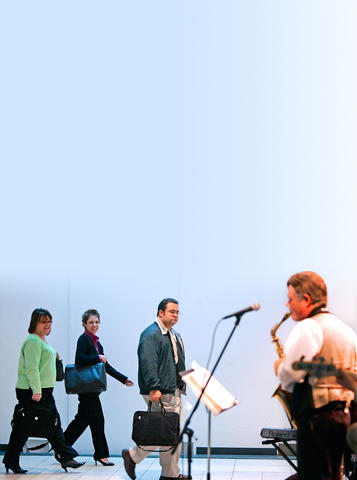Members of the audience dash off suddenly during his show. Others talk on cellphones, read novels or wolf down sandwiches.
John Bontempi takes it all in stride. He strums his guitar and sings another tune near the clanking baggage carousel at Nashville International Airport.
"It took all of history just to make you mine," he warbles from under a dark cowboy hat.

PHOTO: AP
Bontempi is among the 90 or so professional musicians who perform at the airport in its push to add "local flavor," a break from the chain gift shops and restaurants in American airports from Miami, Florida, to Seattle, Washington.
"We're the best gig in town," proclaimed Cathy Holland, the airport's director of community affairs and customer service.
The musicians tend to agree, even if the audience is antsy and the overhead announcements - "The local time is 2:30pm" - get annoying.

PHOTO: AP
"It's a lot of fun. You get a lot of different people coming through," says Bontempi, a singer-songwriter who plays all original material at his monthly two-hour airport shows. "I've had people on their cellphones walk by and say 'Hey, they even have music here - listen' and they hold up their cellphone." Nashville already has one of the busiest airports in the US for live music, but this month it will liven up even more with the opening of Tootsie's, an offshoot of the Tootsie's Orchid Lounge honky-tonk where Willie Nelson and Kris Kristofferson once swapped songs and cold beers.
No one knows for certain, but Nashville International and Austin-Bergstrom International Airport in Texas probably have more live music than any other airport in the US, according to the trade group Airports Council International.
The cities share a rich musical heritage. Nashville's reputation as the capital of country music goes back to the start of the Grand Ole Opry in the 1920s. Austin's thriving independent music scene grew from country roots in the 1970s and is celebrated by thousands of music industry representatives and fans who flock to the annual South By Southwest Festival.
"The airport is the gateway. It's important that it reflect the culture and character of the city," said Jim Halbrook, spokesman for Austin's airport, where a variety of musical acts do 11 shows a week.
Other North American airports have live music on a more limited basis. During the holidays, Boston Logan International and Vancouver International had professional performers and local school choirs.
Lambert-St Louis International has musicians playing a few times a week. Fort Lauderdale Hollywood International in Florida has live entertainment during the fall and winter months.
In Nashville, the airport began offering music in the early 1990s as country music was hitting a growth spurt. Today, musicians of every stripe play its five stages most days of the week.
On the same afternoon Bontempi sang his country songs in baggage claim, a four-piece pop group called the Chessmen performed near the security gate. A handful of people sat at the bar, a few worked at laptops or watched ESPN. When the band broke into Jimmy Buffett's beach anthem Margaritaville, everyone clapped.
"It's a nice touch," remarked Julie Wyte from Alabama. "My husband has been in the military for 20 years and we've been to airports all over the world, and I don't think I've ever seen that before."
Airports across the nation are trying to mirror their cities. At Las Vegas' McCarran International Airport, travelers can play the slot machines. At San Francisco International, they can tour an aquarium. At Palm Beach International in Florida, they can practice their putting.
The airports, in effect, are marketing tools. "The citizens who use them feel at home, and the visitors coming in get a sense of the city without leaving the airport," said Eileen Denne, spokeswoman for Airports Council International.
Nashville's niche has long been its music. From the vintage concert posters on the walls to the guitars and banjos in glass cases, there's no mistaking the airport for any other.
With the opening of Tootsie's - actually, two of them, one in the public area and one in the secure area - travelers can get a feel for the gritty downtown dive where country singers past and present got their starts.
But while the new airport clubs have the same live music and decor as the original, don't expect the same rough edges, like beer-soaked floors and walls covered with graffiti and faded stars' portraits.
"You've got to get that with age. You get that with hard knocks," owner Steve Smith said.
Still, for singers and musicians like Bontempi, the airport remains a sweet gig. For one thing, it pays - US$32.50 per hour for the side musicians, US$65 per hour for the frontman. Not bad in a town so crammed with people trying to get discovered that they'll play for free.
And while the audience is far from rapt, they can be appreciative.
As Bontempi performed, a stocky guy with a beard walked by once, twice and a third time before finally setting down his bags and fixing his attention on the tiny stage.
The man, a 28-year-old welder from Sacramento, California, named Keith Branson, smiled and nodded with the music.
"At least now I can say I heard a country singer in Nashville," he said.

Nov. 11 to Nov. 17 People may call Taipei a “living hell for pedestrians,” but back in the 1960s and 1970s, citizens were even discouraged from crossing major roads on foot. And there weren’t crosswalks or pedestrian signals at busy intersections. A 1978 editorial in the China Times (中國時報) reflected the government’s car-centric attitude: “Pedestrians too often risk their lives to compete with vehicles over road use instead of using an overpass. If they get hit by a car, who can they blame?” Taipei’s car traffic was growing exponentially during the 1960s, and along with it the frequency of accidents. The policy

Hourglass-shaped sex toys casually glide along a conveyor belt through an airy new store in Tokyo, the latest attempt by Japanese manufacturer Tenga to sell adult products without the shame that is often attached. At first glance it’s not even obvious that the sleek, colorful products on display are Japan’s favorite sex toys for men, but the store has drawn a stream of couples and tourists since opening this year. “Its openness surprised me,” said customer Masafumi Kawasaki, 45, “and made me a bit embarrassed that I’d had a ‘naughty’ image” of the company. I might have thought this was some kind

What first caught my eye when I entered the 921 Earthquake Museum was a yellow band running at an angle across the floor toward a pile of exposed soil. This marks the line where, in the early morning hours of Sept. 21, 1999, a massive magnitude 7.3 earthquake raised the earth over two meters along one side of the Chelungpu Fault (車籠埔斷層). The museum’s first gallery, named after this fault, takes visitors on a journey along its length, from the spot right in front of them, where the uplift is visible in the exposed soil, all the way to the farthest

The room glows vibrant pink, the floor flooded with hundreds of tiny pink marbles. As I approach the two chairs and a plush baroque sofa of matching fuchsia, what at first appears to be a scene of domestic bliss reveals itself to be anything but as gnarled metal nails and sharp spikes protrude from the cushions. An eerie cutout of a woman recoils into the armrest. This mixed-media installation captures generations of female anguish in Yun Suknam’s native South Korea, reflecting her observations and lived experience of the subjugated and serviceable housewife. The marbles are the mother’s sweat and tears,